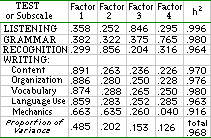Shiken: JALT Testing & Evaluation SIG Newsletter
Vol. 5 No. 1. April 2001. (p. 15 - 19) [ISSN 1881-5537]
What is an eigenvalue? |
 James Dean Brown University of Hawai'i at Manoa |
[ p. 15 ]
 Table 1. Results of Principal Components Analysis of
Table 1. Results of Principal Components Analysis ofthe Japanese Placement Tests at the University of Hawai'i (from Kondo-Brown & Brown, 2000) |
[ p. 16 ]
 Table 2. Results of the Four Factor Analysis After Varimax Rotation - Revised Versions |
[ p. 17 ]
 Figure 1. Scree plot for the analysis shown in Table 1 |
[ p. 18 ]
Using a theory-based approach. The fourth approach discussed here is to use the number of factors that your theory would predict. The simplest theory of the structure of the variance in the example data shown here would be that each test would be relatively independent (because they are designed to test different skills involved in overall Japanese language ability). At the same time, any such theory would predict that the subtests of the Writing test would be relatively similar. Thus one factor for each of the four tests would make the most sense theoretically. Since each of the four factors contributes non-trivial amounts of variance and fits a logical theory for these data, we had two reasons for accepting a four-factor solution.[ p. 19 ]